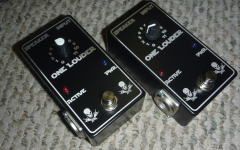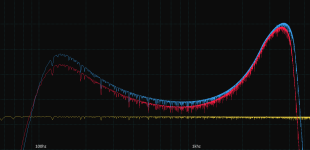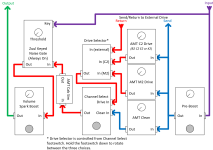Paul.Ruby
Active member
I've spent an inordinate amount of time creating a combo build with 3 footswitches in a 1590DD case. The picture tells most of the story. I'm happy to share info about it if anyone is interested... I'm wondering if anyone else has any interest in such a thing.... To make this all fit, I had to make custom PCBs, such as making the ZUUL (actually a Muzzle) as small as possible.
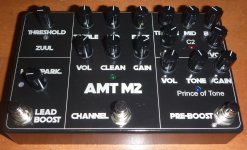
Guts pic... Ordinary soft-touch controllers are used for pre-boost and post-boost. The channel selector module is more complex and described below. The little hand-made PCB on the back of the ZUUL limits the the supply to 9V DC since the ICL7660 that makes negative voltage has a 10V max. Everything else in the pedal can accept up to 18V if desired.
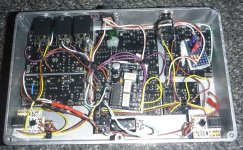
It's very modular, despite being hard-wired in an individual build. The Zuul (actually a Muzzle) and Spark are always there with the Zuul always on. The full LA2 in the middle can be any LA2. The PCB has all the component options on it, but I really like the M2 as the core of my board. I have several different preboost PCBs that all fit the same three knob holes: Prince of tone, TS-808, OCD, Plexi Drive, Landgraph OD. I also have a REVV G2 PCB (Actually a Malachite) for pre-boost but that needs two more knob holes. Above the pre boost is an alternate drive channel. I have a PCB that can make an AMT B2, C2, E2, K2 or M2 as a stand-alone drive module to fit that spot. And I have a send/return for a 3rd drive channel as well. The picture below shows this in action to compare the various LA2 drive channels. M2 and K2 are installed in the main pedal and then B2, C2 and E2 in separate modules for comparison. But, any OD pedal can be put in the 3rd option as the drive channel. My buddy is going to put a Fortin NATAS pedal in that spot.
The channel select footswitch has an ATtiny84 as it's controller to manipulate 3 latching relays. It always switches between clean and drive but, if held down for a half second, it will switch to the next available drive channel option: M2, then other internal (K2 here), then external (C2 here) and back to M2. Once you see the one you want, release the switch to make it the drive channel. It also senses if there is an external drive channel plugged in and will skip that if nothing is being returned there.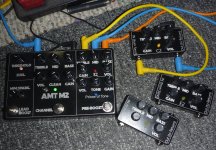
This will eventually be paired with a pedal board power amp with integrated DI with XLR out. That's two pedals, plus tuner and wet effects for a complete setup.

Guts pic... Ordinary soft-touch controllers are used for pre-boost and post-boost. The channel selector module is more complex and described below. The little hand-made PCB on the back of the ZUUL limits the the supply to 9V DC since the ICL7660 that makes negative voltage has a 10V max. Everything else in the pedal can accept up to 18V if desired.

It's very modular, despite being hard-wired in an individual build. The Zuul (actually a Muzzle) and Spark are always there with the Zuul always on. The full LA2 in the middle can be any LA2. The PCB has all the component options on it, but I really like the M2 as the core of my board. I have several different preboost PCBs that all fit the same three knob holes: Prince of tone, TS-808, OCD, Plexi Drive, Landgraph OD. I also have a REVV G2 PCB (Actually a Malachite) for pre-boost but that needs two more knob holes. Above the pre boost is an alternate drive channel. I have a PCB that can make an AMT B2, C2, E2, K2 or M2 as a stand-alone drive module to fit that spot. And I have a send/return for a 3rd drive channel as well. The picture below shows this in action to compare the various LA2 drive channels. M2 and K2 are installed in the main pedal and then B2, C2 and E2 in separate modules for comparison. But, any OD pedal can be put in the 3rd option as the drive channel. My buddy is going to put a Fortin NATAS pedal in that spot.
The channel select footswitch has an ATtiny84 as it's controller to manipulate 3 latching relays. It always switches between clean and drive but, if held down for a half second, it will switch to the next available drive channel option: M2, then other internal (K2 here), then external (C2 here) and back to M2. Once you see the one you want, release the switch to make it the drive channel. It also senses if there is an external drive channel plugged in and will skip that if nothing is being returned there.

This will eventually be paired with a pedal board power amp with integrated DI with XLR out. That's two pedals, plus tuner and wet effects for a complete setup.



